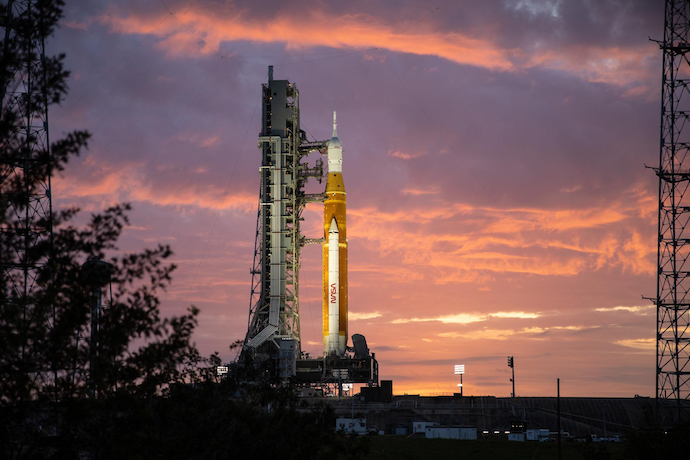The Platform
Latest Articles
by Obaidurrahman Mirsab
by Sudhanshu Tripathi
by Amina Jabbar
by Gordon Feller
by Manish Rai
by Sundus Safeer
by Gordon Feller
by Theo Casablanca
by Peter Marko Tase
by Abdul Mussawer Safi
by Obaidurrahman Mirsab
by Sudhanshu Tripathi
by Amina Jabbar
by Gordon Feller
by Manish Rai
by Sundus Safeer
by Gordon Feller
by Theo Casablanca
by Peter Marko Tase
by Abdul Mussawer Safi
NASA has a Lot Riding on its Artemis Program
NASA intends to start sending astronauts back to the Moon to lay out a lunar base in anticipation of sending astronauts to Mars. The series of progressively complex missions are known as the Artemis program. On or around the beginning of September, NASA intends to launch an uncrewed Artemis 1 megarocket to the moon.
The Artemis 1 launch was scrubbed due to unforeseen circumstances. “We don’t launch until it’s right,” NASA Administrator Bill Nelson said during an interview. “There are certain guidelines. And I think it’s just illustrative that this is a very complicated machine, a very complicated system, and all those things have to work, and you don’t want to light the candle until it’s ready to go.”
Artemis 1 is to be followed by Artemis 2 with astronauts on board in 2024 followed by Artemis 3 in 2025.
The problem for NASA is that it is hurrying to meet its deadlines.
“I keep seeing the pieces of the puzzle but we’re struggling with how the pieces of the puzzle are actually going to fit together and work together,” said Dan Dumbacher, the Executive Director of the American Institute of Aeronautics and Astronautics.
Dumbacher, who cautioned Congress this spring that NASA’s “piecemeal, clumsy methodology is ill-fated to disappointment,” is among various insiders, veterans, and oversight specialists who are sounding the alarm.
Is it past the point where it is possible to get it right in time for an arranged Moon landing in 2025? “Three years isn’t much of time,” said Patricia Sanders, an independent aerospace consultant.

Another factor, she says, has been the ascent of the private space industry and NASA’s dependence on SpaceX’s Starship, which has been chosen as one of the Moon landers. “The business is presently a huge player, while [in the past] it wasn’t,” Sanders suggests that the new plans mean extra oversight challenges for NASA.
NASA’s re-visitation to the Moon has been firmly laid out. In 2019, former Vice President Mike Pence declared that the Moon objective was being accelerated from 2028 to 2024.
The Biden administration at first chose to stay with the arrangement. In any case, last year, NASA’s Bill Nelson declared the timetable was being pushed back to no sooner than 2025.
Vice President Kamala Harris, who chairs the National Space Council, has said little regarding the Moon mission. “We’re extremely amped up for that,” she recently told officials. Her office declined to remark about whether she has worries about the administration of the Artemis program.
The first of three arranged missions requires Boeing’s Space Launch System rocket to send off the Lockheed Martin Orion spacecraft on a 42-day venture around the Moon prior to returning to Earth.
The mission “is vital in light of the fact that this is an experimental drill,” Nelson told journalists this month. “Something is the intensity safeguard. The intensity safeguard has not been flown previously.” Some are transparently anxious about the reality it will be tried just a single time prior to shuttling humans.
“It’s one test and afterward individuals,” said Lori Garver, who previously led NASA. “Assuming your one test has something that provides you [an] opportunity to stop and think to having individuals sometime later, the trouble is it is two years until you test once more.”
Up next will be Artemis II, a 10-day mission scheduled for 2024. It will fly NASA astronauts around the Moon and then return back to Earth.
Following that is Artemis III, which will fly astronauts to the Moon sometime in 2025. The Moon lander, a rendition of SpaceX’s industrially evolved Starship space apparatus, is facing some technical issues.
The lander will likewise require numerous refueling in transit to make the excursion to the lunar surface. That will “require four or five or six send-offs to place the fuel into space,” noted John Logsdon of George Washington University’s Space Policy Institute, adding that signifies “a great deal of spots for disappointment.”
In the final analysis, there is too much riding on the current space program for it to fail.
Dr. Luciano Magaldi is a security engineer with deep expertise in cybersecurity, new technologies, and geopolitics. He is an Honorary Member of the White House Historical Association and an Official Alumnus at Stanford Alumni Association-Club of Los Angeles and at Cambridge at Harvard Alumni for Education Association. He is an Opinion Contributor for the New York Weekly, The London Globalist, The Los Angeles Journal, and Modern Diplomacy. He's worked for Google IE, Apple EU HQ, Amazon SL, and Microsoft PT.